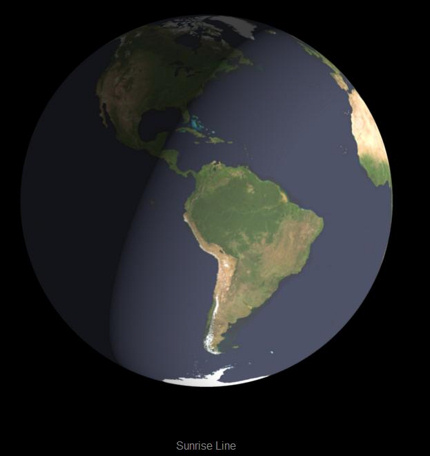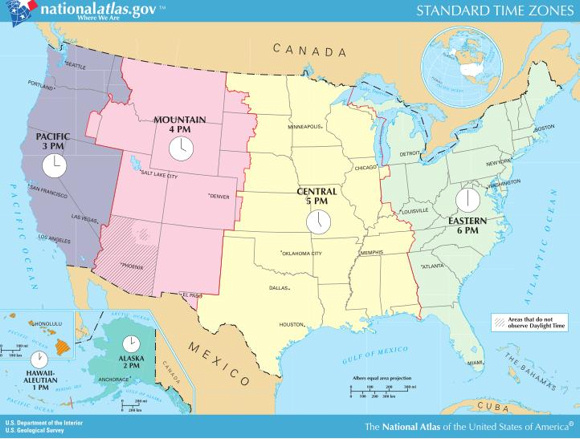
Around the time of the December solstice, the sun rises at the same time for both New York City and St. Augustine, Florida. On December 21, 2020, the sun rises at 7:16 a.m. Eastern Standard Time (EST). Look above at the simulated view of Earth as the sun is rising over the Atlantic seaboard of the United States around the time of the December winter solstice. Note that the terminator – the sunrise line – pretty much aligns with the U. S. East Coast, providing a similar sunrise time for coastal dwellers.
EarthSky lunar calendars are cool! They make great gifts. Order now. Going fast!
And yet, at this solstice, St. Augustine has about an hour more daylight than New York City. Although the sunrise occurs at the same time for both cities, the sunset happens about an hour later in St. Augustine. (See the sunrise/solar noon/sunset table below.)
Sunrise/solar noon/sunset times on December 21, 2020
| City | Sunrise | Solar Noon | Sunset |
| New York | 7:16 a.m. | 11:54 a.m. | 4:29 p.m. |
| St. Augustine | 7:16 a.m. | 12:23 p.m. | 5:30 p.m. |
Source: Sunset Sunrise Calendars
St. Augustine lodges about 7.5 degrees of longitude to the west of New York City. And our planet takes about 30 minutes to rotate this 7.5 degrees. Therefore, on any day of the year, the sun reaches its noontime position some 30 minutes later in St. Augustine than it does in New York City. For instance, on December 21, 2019, the noonday sun reaches its high point for the day at 11:54 a.m. EST in New York City. In St. Augustine, solar noon comes nearly 30 minutes later, at 12:23 p.m. EST.
St. Augustine resides appreciably south of New York City, so St. Augustine’s morning daylight (from sunrise to solar noon) lasts about 30 minutes longer than it does in New York City on the first day of winter. Thus, the longer period of daylight in St. Augustine cancels out the earlier noontime appearance of the sun in New York City, to give both localities the same sunrise time on the day of the December solstice.

Enter the equinoxes
Some three – and nine – months after the December solstice, St. Augustine and New York City receive the same amount of daylight on the days of the March and September equinoxes. On the equinoxes, noontime as well as sunrise and sunset come about 30 minutes later in St. Augustine than they do in New York City. The simulated view of Earth below shows the terminator – the sunrise line – running due north and south on the equinox. Neither the sunrise terminator nor sunset terminator comes anywhere close to aligning with the U.S. East Coast at either equinox.
Sunrise/solar noon/sunset times on March 20, 2021
| City | Sunrise | Solar Noon | Sunset |
| New York | 6:58 a.m. | 1:03 p.m. | 7:09 p.m. |
| St. Augustine | 7:28 a.m. | 1:32 p.m. | 7:37 p.m. |

Sunrise/solar noon/sunset times on September 22, 2021
| City | Sunrise | Solar Noon | Sunset |
| New York | 6:44 a.m. | 12:49 p.m. | 6:54 p.m. |
| St. Augustine | 7:14 a.m. | 1:18 p.m. | 7:22 p.m. |
Source: Sunset Sunrise Calendars
Enter the June solstice
Six months after the December solstice, it’s the June summer solstice for the Northern Hemisphere, coming yearly on or near June 21. Now, the situation is reversed from the December solstice, with New York City receiving about an hour more daylight.
Because New York City lies appreciably north of St. Augustine, New York City’s afternoon daylight (from solar noon to sunset) lasts some 30 minutes longer than in St. Augustine on the day of the June summer solstice. Thus, the extra daylight in New York City cancels out the later noontime in St. Augustine, to give both localities the same sunset time on the June solstice. (See sunrise/solar noon/sunset table below.)

Look above at the simulated view of Earth as the sun is setting over the Eastern seaboard of the United States on the day of the summer solstice. Note that the terminator – the sunset line – pretty much coincides with the East Coast, giving a similar sunset time for residents along the Atlantic seaboard.
From sunrise to sunset on the day of the June solstice, New York City residents enjoy about an hour more daylight than those in St. Augustine. Although the sunset occurs at about the same time for both cities, the sunrise happens an hour earlier in New York City on the day of the summer solstice.
Sunrise/solar noon/sunset times on June 20, 2021
| City | Sunrise | Solar Noon | Sunset |
| New York | 5:25 a.m. | 12:58 p.m. | 8:30 p.m. |
| St. Augustine | 6:25 a.m. | 1:27 p.m. | 8:29 p.m. |
Source: Sunset Sunrise Calendars
Bottom Line: On the day of the December winter solstice, the sun rises at the same time in both St. Augustine, Florida, and New York City, New York, but St. Augustine enjoys an hour more daylight. Six months later, on the day of the June solstice, it’s the sunset that happens at the same time in both places, but with New York City enjoying the extra hour of daylight.











